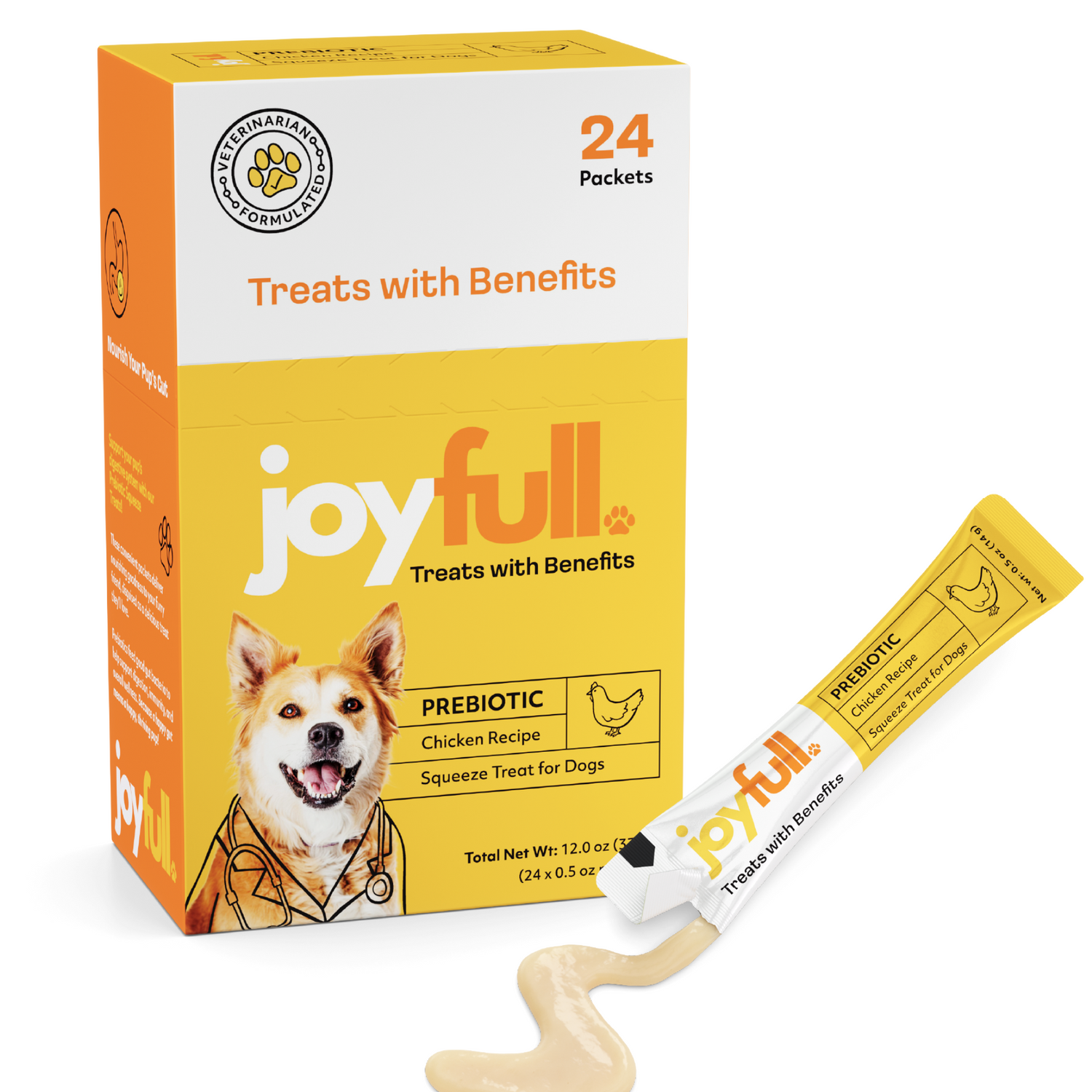
Finding the Best Healthy Treats for Dogs
When it comes to the best healthy treats for your dog, think simple. The gold standard is treats made with whole-food ingredients and single-source proteins, without any artificial junk. Look for recognizable ingredients like dehydrated sweet potato, freeze-dried salmon, or dental chews with minimal processing. This way, you know the reward you're giving actually supports their well-being.
Why Choosing Healthy Dog Treats Is So Important
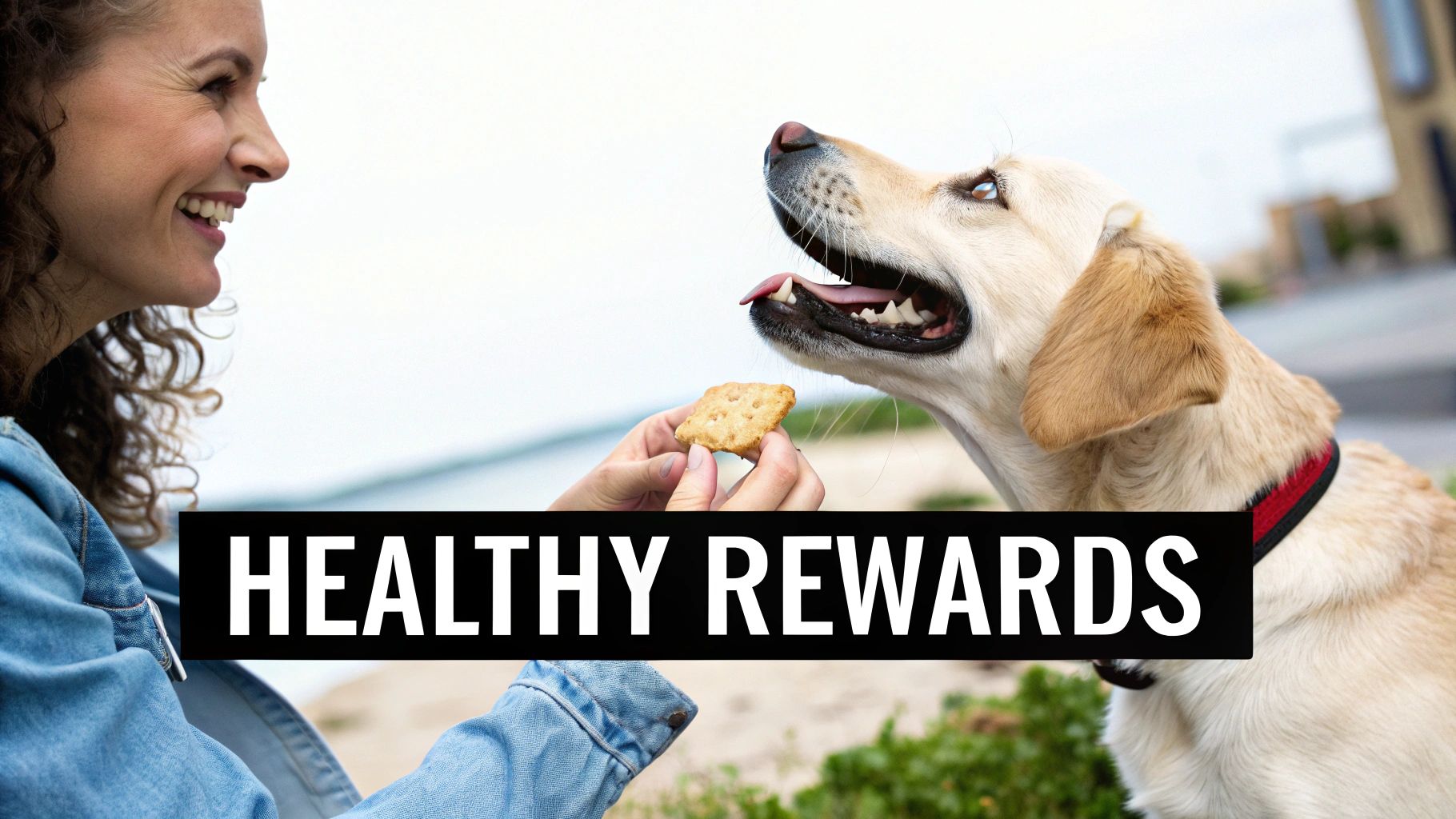
Handing your dog a treat is about so much more than a quick reward—it’s a health decision. Every single snack contributes to their overall nutrition, and making a thoughtful choice is a huge part of being a responsible dog owner today. The right treats can actively boost a balanced diet, but the wrong ones can sneak in harmful fillers, empty calories, and artificial additives.
This daily choice has a direct line to everything from your dog's weight and dental health to their energy levels and even how long they live. It’s a chance to turn a simple moment of joy into a genuine wellness boost.
The Rise of Conscious Pet Parenting
Let's face it: most of us see our dogs as family. This mindset, sometimes called "pet humanization," has completely changed the game, fueling a massive demand for pet products that meet the same high standards we have for ourselves. The global dog treats market says it all—it's growing from an estimated USD 15.36 billion in 2024 and is projected to hit USD 28.60 billion by 2030.
This isn't just about money; it shows a real shift in how we care for our dogs. We're all looking for treats that do more than just taste good.
Choosing a healthy treat is one of the easiest daily actions you can take to support your dog’s long-term health. It’s a small decision with a cumulative, powerful impact on their quality of life.
Beyond the Basic Biscuit
Making smart choices means learning to see past the flashy packaging and clever marketing. The goal is to find treats that actually serve a purpose. Maybe it's a dental chew that helps clean their teeth, a snack with glucosamine for joint support, or a pure, single-ingredient treat for a sensitive stomach. By focusing on quality, you can make sure every treat is a net positive for your dog's diet.
Thinking about your pet’s overall well-being, especially during festive times, reinforces why these small, daily choices matter so much. For more on this, check out these excellent holiday pet safety tips. Building this foundation of knowledge helps you make better decisions every single day, turning treat time into a truly health-boosting activity.
How to Read a Dog Treat Ingredient Label
Ever find yourself standing in the pet food aisle, completely overwhelmed by the wall of treat bags? I've been there. The ingredient lists can look like they were written for a chemistry final, not for a snack. But learning how to decipher those labels is the most important skill you can have when picking out healthy treats. It all comes down to knowing what to look for—and what to run from.
Here’s the first thing you need to know: ingredients are always listed by weight. That means the first few items on the list are what make up the majority of the treat. You want to see real, recognizable foods right at the top.
Spotting the Good Stuff
When you grab a bag, your eyes should immediately scan for a specific, whole-protein source as the number one ingredient. Vague terms are an instant red flag. You don't want to see "meat"; you want to see "chicken," "beef," "salmon," or "lamb." That kind of specificity tells you the company isn't trying to hide a mix of low-quality mystery proteins.
After the protein, look for whole foods like fruits and vegetables. Things like sweet potatoes, blueberries, carrots, and pumpkin are fantastic additions. They pack in natural vitamins and fiber, meaning the manufacturer doesn't have to rely on a long list of synthetic supplements.
A short, understandable ingredient list is almost always a win. If you can't pronounce half the ingredients, it’s probably best to put that bag back on the shelf.
Red Flags to Avoid at All Costs
Knowing what to look for is only half the battle. You also have to know what to avoid. So many popular dog treats are loaded with cheap fillers and questionable additives that provide zero nutritional value. Spotting these is your best defense.
Here are some of the most common red flags to watch out for:
- Vague Protein Descriptions: Terms like "meat and bone meal" or "animal by-products" are a huge no-no. They’re catch-all phrases for low-quality, rendered animal parts. Always stick to named proteins.
- Artificial Preservatives: Keep an eye out for chemicals like BHA, BHT, and ethoxyquin, which have been linked to health problems. Natural preservatives, such as mixed tocopherols (a form of vitamin E) or rosemary extract, are much safer.
- Artificial Colors and Flavors: Your dog doesn’t care if a treat is bright red. Dyes like Red 40, Yellow 5, and Blue 2 are only there to appeal to you, the human, and can trigger allergic reactions in some dogs.
- Sweeteners: Dogs have a sweet tooth, but things like corn syrup, sucrose, and other sugars are a fast track to obesity and dental issues. A little natural sweetness from fruit is fine, but added sugars are a hard pass.
To make this even easier, here’s a quick-reference table to help you compare the good stuff versus the junk.
Healthy Ingredients vs. Red Flag Ingredients
| Look For These ✅ | Avoid These ❌ |
|---|---|
| Named proteins (e.g., chicken, beef, salmon) | Vague terms like "meat" or "animal by-product" |
| Whole fruits & vegetables (e.g., sweet potato, pumpkin) | Fillers like corn, wheat, and soy |
| Natural preservatives (e.g., mixed tocopherols) | Artificial preservatives (e.g., BHA, BHT, ethoxyquin) |
| Natural sweeteners (from fruit sources) | Added sugars (e.g., corn syrup, sucrose) |
| Easily recognizable ingredients | Artificial colors (e.g., Red 40, Blue 2) & artificial flavors |
Think of this table as your cheat sheet for the pet store aisle. It’s a simple way to quickly vet a treat before you even put it in your cart.
When you look at simple, homemade recipes, you can see just how few ingredients it takes to make a treat that's both healthy and delicious.
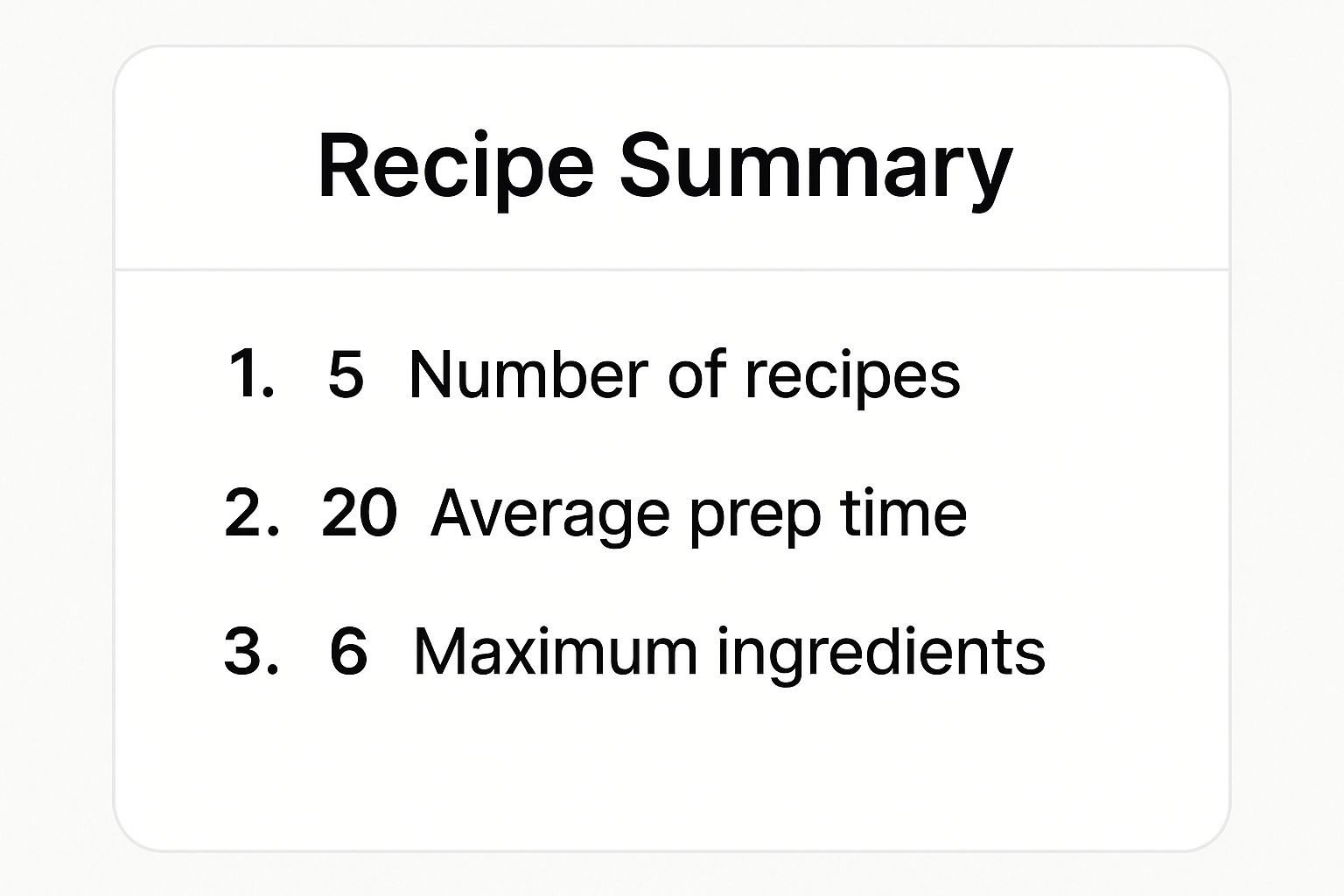
This just goes to show you can whip up amazing treats with an average of six ingredients in about 20 minutes. Quality doesn’t have to be complicated.
Getting familiar with which ingredients to avoid is a huge step in becoming a more confident pet owner. If you want to go deeper, check out our guide on the top ingredients to avoid in dog treats. A little bit of knowledge about reading labels turns you from just another shopper into your dog’s best health advocate.
Exploring the Different Kinds of Healthy Dog Treats
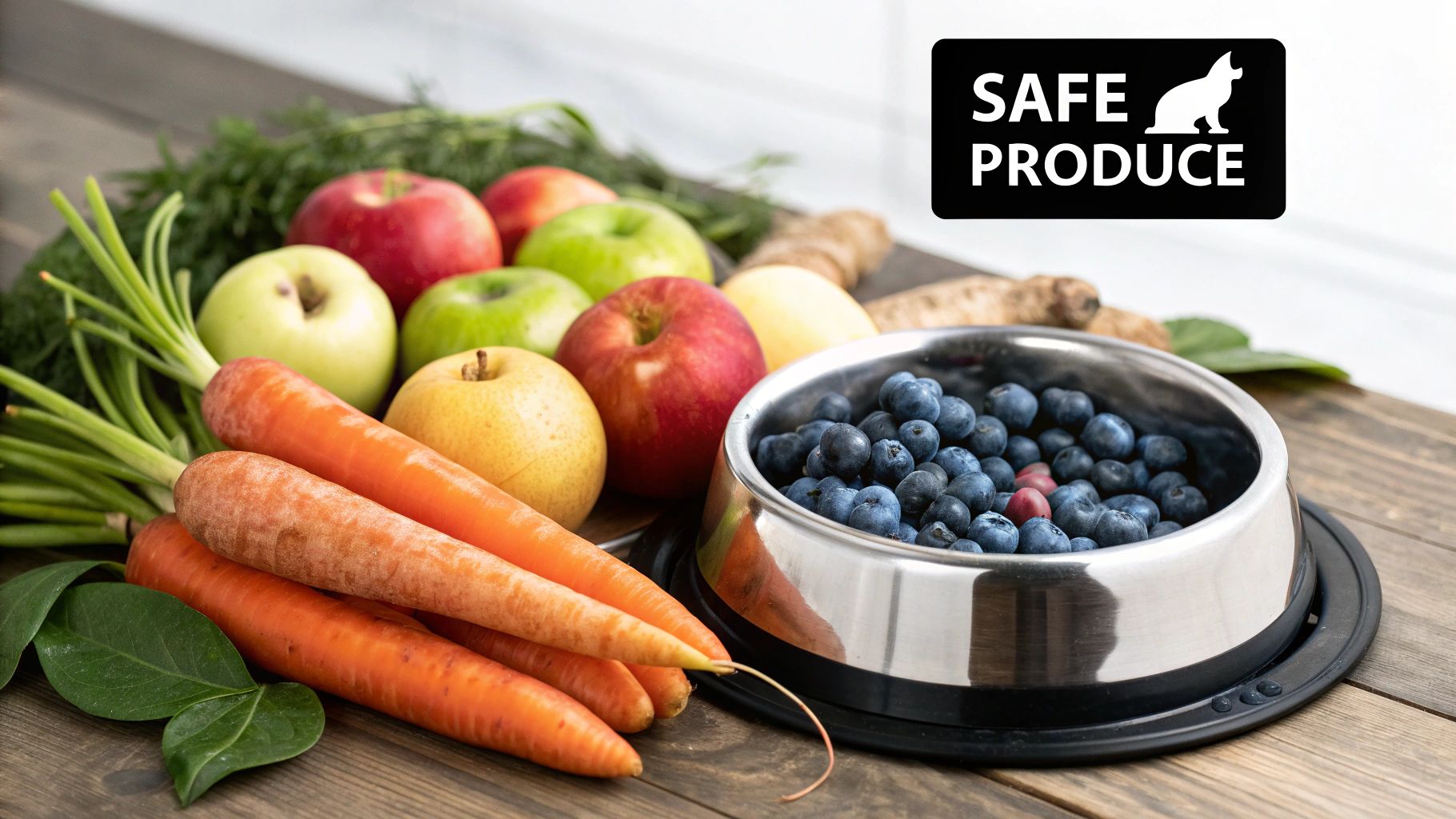
The dog treat aisle has exploded in recent years, and it's a far cry from the days when a simple, bone-shaped biscuit was your only option. Today, you've got a whole world of choices, and understanding the different categories is the first step to picking the right one. Whether you're house-training a puppy or looking for something to soothe your senior dog's joints, there's a treat designed for that.
This isn't just a trend; it's a fundamental shift in how we view our dogs' nutrition. The global dog treats market ballooned to an estimated USD 7.5 billion by 2023, largely because pet owners are actively searching for natural, functional options. People want treats that do more than just taste good—they want them to support dental health, improve coat shine, and more. You can see the data on these growing dog treat market trends for yourself. All this choice is fantastic, but it also means we have to be more discerning than ever.
Training Treats: Small Size, Big Impact
When you're deep in a training session, repetition is everything. That’s where training treats come in. They’re specifically designed to be small, low-calorie, and super enticing, so you can reward your dog frequently without overfeeding them or ruining their dinner.
Think of these as high-value, bite-sized motivators that keep your dog focused and excited to learn. The best ones are soft and easy to swallow, so your dog isn't spending precious seconds on a lengthy crunch. Things like freeze-dried liver bits or even tiny pieces of plain cooked chicken are perfect for the job.
Dental Chews for a Healthier Smile
A dog's oral health is directly linked to their overall well-being, and dental chews are a fantastic tool for keeping their teeth in good shape. These aren't just regular treats; they're engineered with unique textures and shapes designed to fight plaque and tartar.
The magic is in the mechanical action. As your dog gnaws on the chew, it scrapes away buildup from the surface of their teeth. I always recommend looking for chews that carry an approval seal from veterinary health organizations. For a dog that loves to chew, like a Labrador, a sturdy dental stick can provide minutes of satisfying work while cleaning their teeth at the same time.
Pro Tip: Never leave your dog unsupervised with a dental chew or any long-lasting treat. Staying close by helps prevent choking and makes sure they're chewing safely.
Functional Treats for Targeted Support
Functional treats are where things get really interesting. These are treats formulated with specific ingredients to deliver a targeted health benefit, going way beyond basic nutrition. Think of them as a simple, tasty way to supplement your dog's diet.
Here are a few common examples you’ll find:
- Joint Support: These are a must for many senior dogs or breeds prone to joint issues. They’re usually fortified with glucosamine and chondroitin to help maintain healthy cartilage and mobility.
- Skin and Coat Health: If your dog's coat is looking a little dull, look for treats rich in omega-3 and omega-6 fatty acids. Salmon oil is a fantastic source for this and can make a huge difference.
- Calming Treats: Formulated with gentle, natural ingredients like chamomile or L-theanine, these can be a lifesaver for dogs who get anxious during thunderstorms, car rides, or vet visits.
Single-Ingredient Treats: The Beauty of Simplicity
For any dog owner dealing with food sensitivities or allergies, single-ingredient treats are a game-changer. The name says it all—they're made from just one thing. We're talking about dehydrated sweet potato slices, freeze-dried salmon chunks, or bits of beef liver. Nothing else.
This beautiful simplicity takes all the guesswork out of the equation. You know exactly what's in the bag, making it easy to avoid triggering an allergic reaction. Honestly, these are some of the best healthy options out there because they're pure, unadulterated nutrition without any of the weird fillers or additives that can cause trouble.
Matching Treats to Your Dog's Unique Needs
When it comes to dog treats, a "one-size-fits-all" approach just doesn't cut it. The best treat for your dog is one that’s chosen specifically for them.
Think about it: you wouldn't feed a toddler the same meal as a senior citizen. The same logic applies here. A rambunctious puppy's needs are a world away from those of a gray-muzzled senior dog. It’s all about looking past the flashy packaging and focusing on what will genuinely support your dog’s health and well-being at their specific stage of life.
Treats for Every Life Stage
A dog's nutritional requirements evolve as they grow, so their treats should, too. What's perfect for a young pup could be a bad choice for an older dog.
-
Puppies: These little guys are bundles of energy and growing fast. They need treats that are high in protein and calories to fuel all that development. Soft, small treats are perfect for their baby teeth and work great for the frequent rewards needed during training.
-
Adult Dogs: Once your dog is fully grown, the name of the game is maintenance. Treats should be a healthy supplement to their diet, not a source of empty calories that could lead to weight gain. This is the perfect time to introduce functional treats, like dental chews or snacks with joint support.
-
Senior Dogs: As dogs get older, they tend to slow down. Hard, crunchy treats can be tough on aging teeth and gums, so softer chews are often a better bet. Many seniors also get a real boost from treats with added goodies like glucosamine for joint health or omega fatty acids for brain function.
Size and Health Are a Big Deal
Age is just one piece of the puzzle. Your dog’s breed size and any specific health concerns are just as important. A tiny Chihuahua and a massive Great Dane have completely different dietary needs, just like a dog with a sensitive stomach requires a different kind of snack than one with arthritis.
For instance, a big dog needs a larger, tougher chew to avoid gobbling it down and creating a choking hazard. A small dog, on the other hand, needs something tiny and low-cal to keep their weight in check.
If your dog struggles with stiff joints, a snack designed to help with inflammation can make a world of difference. For a closer look at this, our guide on choosing the best dog treats for arthritis has some great, specific advice.
When your dog has a known health issue, the treats you choose are more than just a snack—they're part of their overall care plan. It's always a good idea to chat with your vet to make sure your treat choices fit their recommended diet.
This push for personalization is making waves in the pet food world. We’re seeing a big trend in the premium dog treat market toward alternative proteins. Things like venison, kangaroo, and even insect-based proteins are gaining traction because they're fantastic for dogs with allergies to common proteins like chicken or beef. You can learn more about how these novel protein trends are shaping pet treats and giving sensitive dogs better options.
Ultimately, picking the right treat is about seeing your dog as an individual. Is your pup on a diet? Stick with super low-calorie options like single-ingredient veggie chews. Do they have a sensitive stomach? A limited-ingredient treat with a novel protein like lamb or fish is a much safer choice. This careful approach turns every treat into a small step toward a healthier, happier dog.
Whip Up Some Love: Simple and Safe Homemade Dog Treats
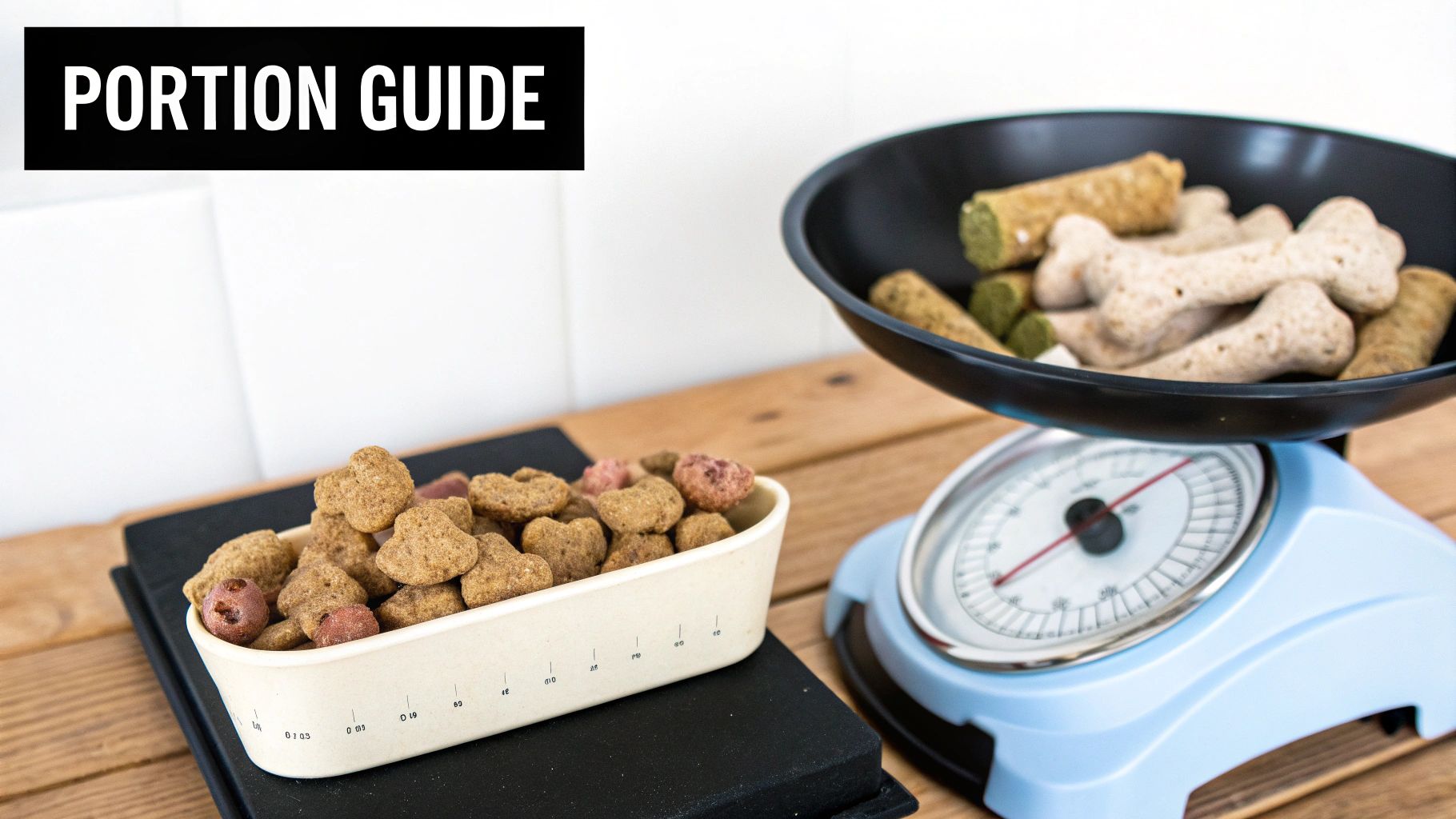
There's something incredibly satisfying about making your dog's treats from scratch. If you're like me and love a good kitchen project, this is the perfect way to take total control over what goes into your pup's snacks. You know exactly what's in them—no weird fillers, hidden allergens, or artificial junk. It’s peace of mind you can bake.
You don't need to be a professional baker, either. A few simple, wholesome ingredients from your pantry are all it takes to create something your dog will go wild for. Let's walk through a few of my favorite, time-tested recipes that are easy to make and store.
Classic Pumpkin & Peanut Butter Biscuits
This one is a classic for a reason. Seriously, what dog doesn't love peanut butter and pumpkin? Pumpkin is a powerhouse for digestive health, packed with fiber, and the peanut butter adds a dose of healthy fats and protein.
Here’s the game plan:
- First, get your wet ingredients together. Mix 1 cup of pure pumpkin purée (make sure it's not the sweetened pie filling!) with 1/2 cup of all-natural peanut butter and 2 large eggs. It's crucial that your peanut butter is xylitol-free, as xylitol is toxic to dogs.
- Once that's smooth, gradually work in 2 1/2 cups of whole wheat flour until you get a nice, stiff dough.
- Roll it out on a floured surface to about 1/4-inch thickness and have fun with your cookie cutters.
- Pop them on a baking sheet and bake at 350°F (175°C) for about 20-25 minutes. You're looking for them to be golden and firm.
Just let them cool completely before you let your dog do a taste test. These will keep in an airtight container for up to two weeks.
Sweet Potato Jerky Chews
Does your dog live to chew? Forget the store-bought jerky and try this single-ingredient wonder. Sweet potatoes are loaded with vitamins, and they bake into a fantastic, chewy texture that can even help with your dog’s teeth. It doesn't get simpler than this.
All you have to do is wash a large sweet potato and slice it into 1/4-inch thick rounds. Lay them out in a single layer on a parchment-lined baking sheet and bake them low and slow at 250°F (120°C) for 2.5 to 3 hours. Flip them about halfway through to make sure they dehydrate evenly.
These chews are great stored in an airtight container in the fridge, where they’ll last up to three weeks. For a longer-term stash, just pop them in the freezer.
Frozen Berry & Yogurt Bites
On a hot day, nothing beats a frozen treat. These little bites are a fantastic way to help your dog cool down, and they're bursting with goodness. The berries provide antioxidants, and the yogurt offers a dose of probiotics for gut health.
It's as easy as it sounds:
- Ingredients: You’ll need 1 cup of plain, unsweetened yogurt (Greek yogurt is a great choice) and 1/2 cup of mixed berries, like blueberries or chopped strawberries.
- Preparation: Toss everything in a blender and blitz until it's smooth.
- Freeze: Pour the fruity yogurt mixture into an ice cube tray or some fun silicone molds. Freeze them for a few hours until they're solid.
These are the perfect low-calorie reward on a summer afternoon.
If you get the baking bug and want to try even more ideas, we’ve put together a whole collection of healthy dog treat recipes to keep things interesting. Your dog will definitely appreciate the homemade love.
A Few Common Questions About Healthy Dog Treats
Even after you've learned to spot good ingredients and know which types of treats to look for, some questions always seem to come up. Let's run through a few of the ones I hear most often from fellow dog owners. Getting these sorted will give you that extra bit of confidence when you're picking out snacks for your pup.
Treating your dog is one of life's simple joys, but doing it responsibly is just as important. Think of these as the final details for mastering the art of healthy treating.
How Many Treats Should My Dog Actually Get Per Day?
This is easily the most common question, and it all comes down to one simple concept: balance. As a golden rule, most vets and nutritionists stand by the "10% rule."
What does that mean? It’s pretty straightforward: treats should never account for more than 10% of your dog’s total daily calories.
Following this guideline is the single best way to prevent unhealthy weight gain and make sure your dog is getting the vast majority of their nutrition from their actual meals. To make it work, you just need to know your dog's daily calorie target (your vet can give you this) and the calorie count for each treat, which should be printed right on the bag.
Are Grain-Free Treats Really Better?
The grain-free movement has been a massive trend in pet food, but "grain-free" doesn't automatically mean "healthier." For a dog with a true, diagnosed grain allergy, these treats are a necessity. But for the average dog, healthy whole grains like brown rice or oats are a perfectly good source of energy and nutrients.
The real issue isn't the presence of grains, but what they're replaced with. Some companies pull out the grains only to pack the treat with cheap fillers like potato starch or tons of pea flour. Your focus should always be on the quality of the ingredients overall, not just the absence of one type.
What's the Best Treat for a Dog with a Sensitive Tummy?
If you have a dog with a sensitive stomach, simplicity is your best friend. Your go-to options should be limited-ingredient or even single-ingredient treats. This approach drastically reduces the chances of triggering an upset.
A few tips from my own experience:
- Stick to gentle proteins: Turkey, fish, and lamb are often much easier for sensitive dogs to digest than richer proteins like beef.
- Give freeze-dried a try: Because they're so minimally processed, freeze-dried treats often agree with dogs who have digestive issues.
- Look for tummy-friendly additions: Ingredients like pumpkin and ginger are well-known for their naturally soothing effects on a dog's digestive system.
Anytime you bring home a new treat, always start with a very small piece and keep an eye on your dog for the next day or so. While giving healthy treats is key to your dog’s diet, keeping your home environment clean is also part of being a great pet parent. If you're dealing with stubborn smells, it might be time for professional pet odor treatment.
At Joyfull, we believe that a healthful life isn't just for humans. Our pets deserve it too. We create better-for-you snacks with clean ingredients and high-quality proteins, all reviewed by our in-house veterinary advisor. Explore our collection at https://joyfullpet.com.
